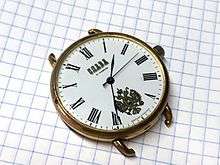Slava watches

Slava (Russian: Cлава, meaning "Glory") watches were classic "civil" Russian watches commonly referred to as "Slava Lava!". The Slava factory (known originally as the Second Moscow Watch Factory) was the second non-military watch maker established in the Soviet Union, in 1924. The watches of this brand have always been meant for civilian consumption, without military or aerospace pretensions.
Slava's own mechanical movements feature two mainspring barrels coupled together with an idler gear. There are many versions of the movement including manual wind 2414 and 2428 (double date)and self-winding 2416 and 2427 (double date). The movements are quite sensitive to shocks due to thin balance staff. Other frequent problems include premature wear of rotor bearing and the clutch driving the hands (not a typical cannon pinion). Also the date indicator malfunctions are common. The movements are thus considered unreliable, especially compared to other Russian calibres. Earlier the 2nd Moscow Factory produced movements derived from an old pre-war French movement, the Lip "T-15" (also some Poljot movements were derived from this French brand), and produced under license (brands Pobeda and Start). In addition to that, for relative brief periods, Slava also produced its own electronic movements using tuning fork and quartz systems. Some Slava watches were produced under Sekonda brand names.
Awards:
- 1964 year - on the Leipzig international fair Slava tuning-fork wrist watch got gold medal
- 1974 year - Slava watches got gold medal at Brno fair
- 1975 year - gold medal at Leipzig international fair
While Slava watches utilize their own Russian-made movements today, and for some models, bought-in movements from Miyota are used.
In the 1990s a lot of Slava movements were exported in China and Hong Kong and can since be found in Chinese production. Some Russian businessmen used them to make fake Slava watches, protecting themselves by changing the logo for "Slava Sozvezdie" (Слава Созвездие) or CJIABA, even though it still presents trademark infringement. Since 2006 the Slava Sozvezdie watches appear in vast quantities, they contain no Russian content but often marked "Russia" on the dial, and are built as cheaply as possible. These watches have nothing to do with the Slava company and are distributed in Russia only through channels usually associated with fake brand watches. Distributors of such fakes declare that rights were bought for the brand, but the Slava brand wasn't registered in China and anybody could produce it there.
As of January, 2006, the Slava factory and its property are to be sold for retail development. As of 2010 the building of the factory has been brought down to make space for new real estate projects. The brand has been taken over by municipality of Moscow in a dept swap.
Exclusive rights for production of Slava watches together with movements and parts from 2006 years being leased to Slava Trade House company. Manufacture facility of Slava TH is located at Uglich in separate workshop of ex-Chaika factory.
In popular culture
In the 2016 film Glory (original title Slava), set in contemporary Bulgaria, the protagonist's Slava watch with an engraving from his father plays a key role in the plot.[1]
References
- ↑ Allan Hunter (8 August 2016). "'Glory': Locarno Review". Screen Daily. Retrieved 22 October 2016.
External links
- Ex-official Slava website (in Russian only and not updated since 2008)
- Website of Slava Trade House (partly translated)